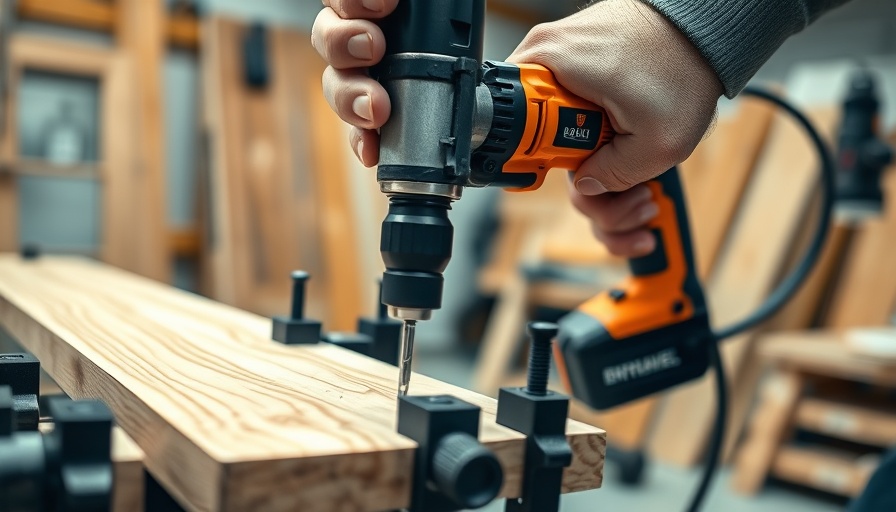
Understanding Your Drill: The Key to Becoming a Pro
When embarking on any DIY project, whether it’s a small weekend task or a larger home renovation, understanding your tools is essential for success. A power drill, particularly a drill/driver, is a primary tool every DIY enthusiast should master. Not only does it serve the practical purpose of drilling holes and driving screws, but it can also enhance the quality and efficiency of your work. In this guide, we will dive into essential techniques, safety measures, and much more to help you use your drill like a pro.
Knowing the Different Types of Drills
It’s important to know that drills come in various forms, each catering to different needs. The standard drill/driver is versatile enough for most tasks, but understanding the distinction between an impact driver and a hammer drill can save you time and produce better results. An impact driver excels at driving screws with high torque, making it a must-have for projects involving heavy materials, while a hammer drill is indispensable for tough surfaces, utilizing a hammering action to drill into masonry.
Drill Anatomy: A Closer Look
Familiarizing yourself with the components of your drill can significantly improve your drilling technique. Key parts include the grip/handle, torque adjustment ring, gear selector switch, and chuck. For instance, the torque adjustment ring determines how much rotational force is applied, which is crucial when working with different materials. Setting it correctly can prevent damage and ensure your screws are secure without stripping.
Essential Drill Bits and Their Uses
Not all drill bits are created equal. Selecting the right bit for the job can make a profound difference in performance. Here are a few key options:
- Twist Bits: These are the most common, effective for wood and softer materials.
- Spade Bits: Ideal for larger holes in wood, spade bits are excellent for applications that don’t require precision.
- Masonry Bits: Specifically designed for drilling into stone, brick, or concrete, they feature a durable tip to withstand hard surfaces.
- Counter Sink Bits: These provide a finished look by allowing screws to sit flush with the surface.
Safety First: Protecting Yourself
While drills are incredibly useful, they also pose potential hazards if not used cautiously. Always wear safety glasses to protect your eyes from debris, and consider using a dust mask when working with materials like wood or drywall to avoid respiratory issues. Ensuring that you have a firm grip and stable footing enhances your control over the drill, reducing the risk of accidents.
Practical Insights into Drilling Techniques
Drilling isn’t just about pressing the trigger and going. Here are some practical tips:
- Mark Your Spot: Utilize painter's tape on your surface to mark your drilling point. This prevents slipping and ensures precision.
- Start Slowly: Begin with a low speed to establish control before applying full pressure. This technique is particularly beneficial for delicate materials.
- Keep It Steady: Maintaining a steady hand helps ensure straight holes, so avoid rushing the process.
Future Trends: Upgrading Your Drill Skills
As technology advances, so do power tools. Battery-powered drills have become more efficient, allowing for longer usage times and less downtime. Additionally, smart drills are beginning to hit the market, with innovative features that help guide users in their projects. Staying informed about these advancements can provide significant advantages in your DIY endeavors and enhance your overall knowledge about home improvement.
Actionable Insights: Taking Your DIY Craft to the Next Level
Before grabbing your drill, take a moment to plan your project. Understanding not just the tools and materials required but also the entire workflow from start to finish can save you time and frustration. This strategic approach transforms your DIY goals from simple tasks into satisfying accomplishments. Whether it’s a shelving project for your living room or an outdoor deck, planning is fundamental.
By incorporating these techniques and insights into your drilling tasks, you’ll not only complete projects more efficiently but also cultivate a greater sense of confidence in your DIY abilities. So, grab your power drill and demonstrate your newfound skills—it’s time to renovate your space!
If you’re excited to dive into home improvement and want to keep learning more about tools, safety measures, or DIY techniques, stay connected and take proactive steps. Your journey to becoming a home improvement pro starts here!
 Add Row
Add Row  Add
Add 




Write A Comment